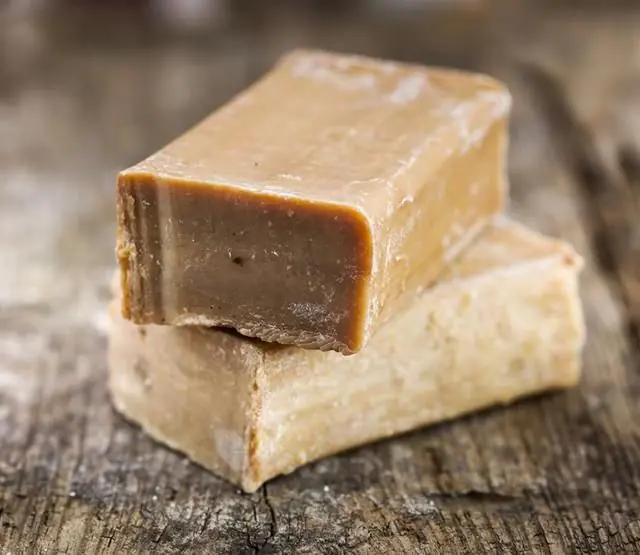
- Description and composition
- The benefits of laundry soap
- How to make laundry soap
- Treatment methods for papillomas
- Contraindications
- Reviews of laundry soap
Laundry soap for papillomas is an effective remedy that will help gently and cost-effectively remove tumors on the skin. It has drying and antiseptic properties and is completely natural and does not cause allergies. Thanks to its exfoliating and wound-healing properties, laundry soap has found application in cosmetology and medicine.
Description and composition of laundry soap for papillomas
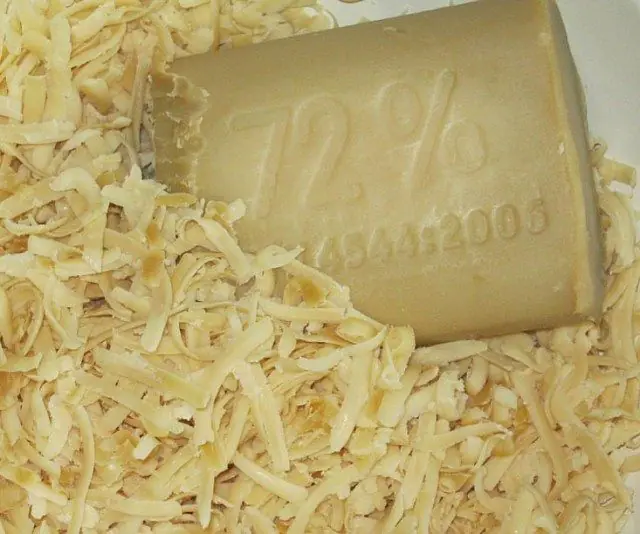
In the photo there is laundry soap for papillomas
Laundry soap is a combination of fatty acids (up to 72%) and alkalis (0.15-0.2%). The source of the former is animal fats with the addition of plant components - lard, sunflower, cottonseed, soybean and other oils. A pronounced alkaline environment with a pH of 11-12 is provided by sodium or potassium salts, including caustic soda, sodium chloride (table salt).
The product category indicated on the packaging depends on the percentage content and quality of purification of fatty acids:
- first category - 70.5-72%;
- second - not lower than 69%;
- third - from 64%.
Laundry soap has 3 release forms, all of which can be used against papillomas:
- Solid. A beige-brown block, familiar to everyone since Soviet times, weighing 180, 200 or 300 grams. The cost of such a piece is 4-8 hryvnia in Ukraine and 15-25 rubles in Russia.
- Liquid. It is produced in plastic containers with a volume of 500 milliliters to 10 liters and is intended primarily for washing. The price for 1 liter in Ukraine is from 15 hryvnia, in Russia - from 60 rubles.
- Powder. Used for washing by hand and in automatic machines. In Ukraine, a package of 180 grams costs 17 hryvnia; in Russia, 300 grams are sold for 40 rubles.
Due to the absence of fragrances, dyes and preservatives, classic laundry soap made in accordance with GOST is an environmentally friendly product with a minimal risk of allergies and is perfect for treating papillomas at home.
However, to improve consumer qualities, synthetic brighteners are added to the product, especially liquid and powder forms, to give a light color, and flavorings to hide the rancid odor. You can find laundry soap with the addition of care oils, which is reflected in the price of the product.
The benefits of laundry soap for papillomas
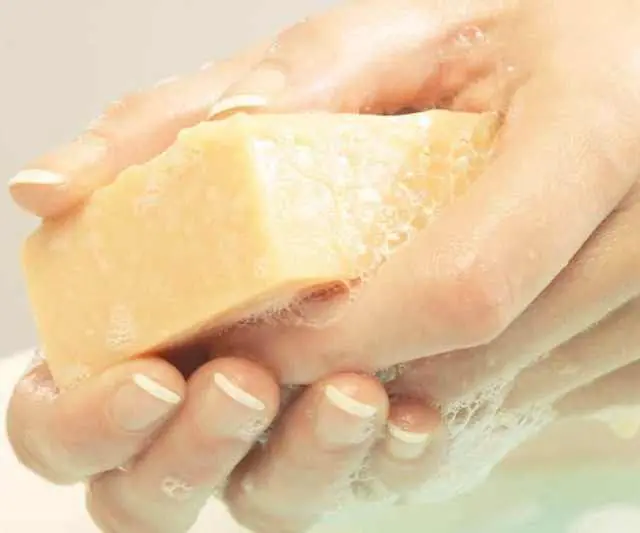
The main effect of laundry soap is drying. Due to its high alkali content, it changes the acidic environment of the water-fat protective layer of the skin, degreasing it. But if you have dry skin, it is not advisable to wash your face with it - using the product leads to loss of elasticity and premature aging of the skin.
Since papillomas are overgrown epithelial cells, they are also sensitive to the effects of laundry soap - the fat-free tissue is dried and peeled off, and the growth is painlessly removed.
Laundry soap has other useful qualities:
- Removes toxins. This property follows from the previous one: reducing fat content stimulates increased work of the sebaceous glands, through which harmful substances are released from the body.
- Disinfects. The product has a destructive effect on the cells of pathogenic microorganisms - bacteria and fungi. Its use for the prevention of infections, including HPV, is justified when visiting public swimming pools and saunas.
- Relieves inflammation and itching. You can use laundry soap for sun and thermal burns, and insect bites.
- Promotes skin regeneration. The product can be used for cracks, scratches, cuts, wounds after removal of papillomas.
- Read also about the benefits of tar soap for papillomas
How to make laundry soap for papillomas at home?
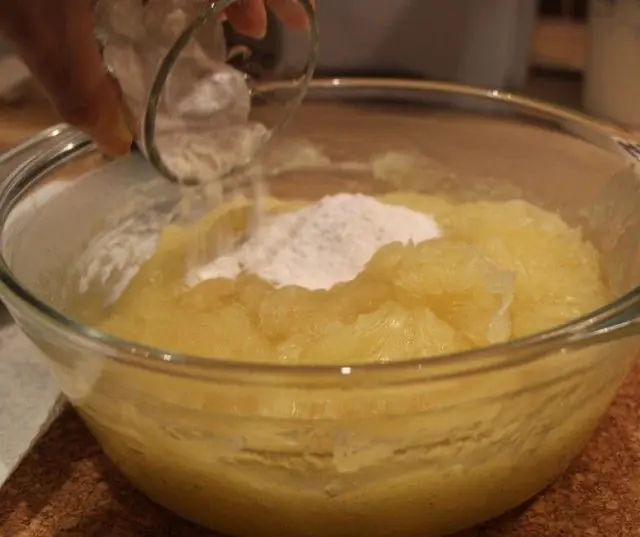
The photo shows the process of making laundry soap for papillomas
Homemade laundry soap for papillomas is completely natural and safe, as well as a fairly cheap product. However, the technology for its preparation has its own characteristics.
Required ingredients:
- Vegetable oils - 1 kg. It is best to use a mixture of olive or sunflower oil (40% or 400 g), coconut (40% or 400 g) and palm oil (20% or 200 g). You can only take sunflower oil, but such laundry soap against papillomas does not last long and quickly goes rancid.
- Water. The water to oil ratio should be 33%. That is, for 1 kilogram of the oil component you need to take 330 milliliters of water.
- Alkali. For 1 kilogram of fat you will need 156 grams of sodium hydroxide (aka caustic soda or caustic soda). But the amount of this ingredient depends on the type of oils and may vary. For example, when making soap only from sunflower oil, you need to take 183 grams of alkali.
These ingredients make an ideal laundry soap for removing papillomas. For more gentle skin care and reduction of dryness, it is recommended to add 2-3% more fat - 20-30 grams of any of the oils.
Note! The weight of components should only be measured in grams or kilograms, and not in liters or milliliters.When preparing laundry soap for papillomas, you will need containers for the ingredients. For solid oils, you need an enamel or metal saucepan that can be heated. Plastic containers are suitable for liquid oil and water. At the same time, the remaining components will need to be poured into the sunflower oil, so the container must be sufficiently voluminous.
You also need to prepare:
- Electronic kitchen scales;
- Protective equipment when working with alkali - rubber gloves, respirator and goggles;
- Silicone spatula;
- Immersion blender or mixer;
- Thermometer for measuring the temperature of components;
- A fine sieve (small diameter is possible) for straining the solution;
- Container for drying finished soap: if there is no special silicone one, you can take any box made of plastic or cardboard, lining its bottom with parchment film;
- Towels or blanket for wrapping soap.
It is not advisable to use dishes and tools for food products after making soap.
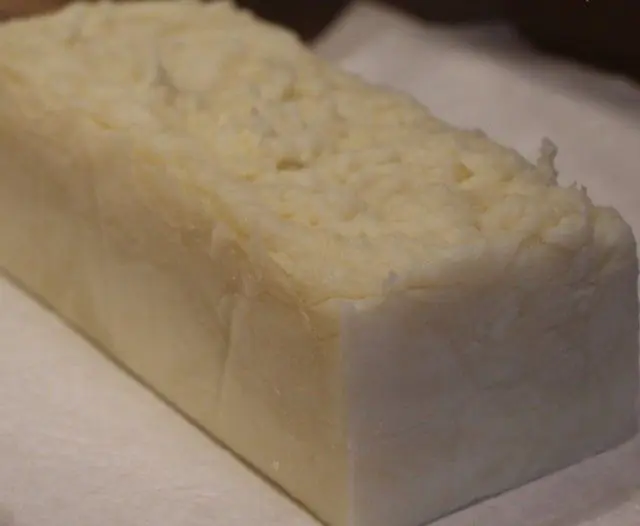
Photo of homemade laundry soap for papillomas
Step-by-step instructions for making laundry soap for papillomas:
- Weigh and measure all ingredients.
- Melt the solid oils in a water bath, then pour them into the liquid oils, removing the residue from the walls of the dish with a silicone spatula.
- Add alkali little by little to pre-chilled water in the refrigerator, stirring thoroughly.
- Heat the alkali solution slightly: it is necessary to add alkaline water to the oils when the temperature of these liquids is above 40 degrees.
- Pour the lye into the oil through a sieve to prevent undissolved sodium hydroxide crystals from getting into the soap.
- Gently stir the mixture with a spatula until the liquid becomes noticeably cloudy. Then use the blender, turning it off periodically. Continue blending until the so-called “mark stage”, when the product has the consistency of sour cream and there are noticeable indentations and other marks from the blender.
- Pour the resulting mixture into the prepared pan, tap it to get rid of bubbles, and cover the top with cling film or a napkin.
- Wrap laundry soap against papillomas, ensuring good heating. Leave for 6-12 hours, then remove and, if necessary, cut with a regular knife, cutter or string.
- In order for the soap to finally “ripen”, it is advisable to let it sit for another 3-6 weeks, but if you really want to, you can use it right away.
- Read also how to treat papillomas with folk remedies
Methods for treating papillomas with laundry soap

The photo shows how to use laundry soap for papillomas
At home, treating papillomas with laundry soap is not difficult. The folk method is based on the drying effect of the product, due to which the cells of the growths lose moisture and are gradually destroyed.
There are several ways to use laundry soap against papillomas:
- Applications. It is advisable to resort to treatment in the evening, after a shower or bath, when the skin is well steamed. Cover the area with the growth thickly with soap foam, doing this carefully so as not to injure the growth. Let the product dry and leave until the morning. The procedures must be repeated every day - gradually you will see how the growth decreases in size. If the skin around the papilloma begins to turn red, treatment with laundry soap must be stopped and wait until the formation dries out on its own and falls off.
- Compresses. Finely grate the soap and add water, leaving for 1 hour. Place the soaked mass on the affected area, cover with cling film and secure with a cloth or adhesive tape. If there is no burning or tingling feeling, leave the product for 3-5 hours. If the discomfort is severe, treatment should be stopped and the skin should be washed. Water can be replaced with vinegar. This mixture must be brought to a boil and allowed to cool. Keep on the body for no longer than 2 hours.
- Ointment. Laundry soap can be combined with other remedies against papillomas, for example, with fresh onions or garlic. Vegetables must be peeled and grated on a fine grater, and the soap must also be crushed into crumbs. Mix onion and soap in a ratio of 1:3, garlic in a ratio of 1:6. For better consistency, you can add a small amount of baby cream. Apply the resulting ointment to the growth, leave for 30-60 minutes, then wash the area with warm water. If there is a burning sensation, you need to cleanse the skin earlier. Repeat the procedure once a day for 3-4 days. Store the product in the refrigerator.
- See also how to use castor oil for papillomas
Contraindications to the use of laundry soap for papillomas

Before removing a papilloma with laundry soap, you need to visit a doctor - a dermatologist or oncologist must confirm that the neoplasm is benign.
It is also important to conduct a skin test: apply a small amount of soap foam or ointment prepared on the basis of the product to the wrist or the inner crease of the elbow. If no redness, burning or itching occurs after a few minutes, the product can be used for treatment.
It is not recommended to use laundry soap for papillomas in the following conditions:
- individual intolerance to the constituent components of the product;
- pregnancy or breastfeeding;
- childhood.
It largely depends on the skin type whether treating papillomas with laundry soap at home will help or harm a person.
With prolonged use, the product can increase dryness and flaking of healthy areas of the skin, leading to cracking. To avoid such side effects, it is advisable to use moisturizing or nourishing creams.- See also contraindications of propolis for papillomas
Real reviews about laundry soap for papillomas

Due to its safe effects, the product is popular when it is necessary to remove skin tumors. Here's what they say about him:
Natalya, 29 years old, Ekaterinburg
I've been wanting to remove a growth on my neck for a long time and finally decided to do it. Girls, laundry soap against papillomas works great! In the morning after the first soaping, the growth became a little smaller in size, and after another week and a half it dried out and fell off, not even a trace remained. So use laundry soap and don’t be afraid!
Tatiana, 29 years old, St. Petersburg
I have a whole scattering of papillomas on my chest. Removing it with a laser is somehow a little expensive, so I decided to try it with laundry soap. I treat it with foam and seal it with adhesive tape. Maybe I'm doing something wrong, but the skin in this area is red, itchy and sore. I'll keep an eye on it for now, and if it doesn't go away, I'll go to the doctor.
Olga, 23 years old, Tver
I have a lot of respect for laundry soap, ever since I had massive teenage acne on my back. I thought that with my oily skin there would be no effect against warts, but unexpectedly I managed to get rid of the annoying papilloma near the armpit. During the shower, I simply lathered the area well and did not wipe it. I myself didn’t notice how the papilloma disappeared.
- Read also reviews about the treatment of papillomas with vinegar
How to remove papillomas with laundry soap - watch the video:
As reviews of laundry soap for papillomas show, this is a universal and effective remedy. But its use must be correct so as not to lead to unpleasant consequences - new multiple rashes or degeneration of the growth into a malignant tumor.
- Related article: What is the difference between papilloma and wart



